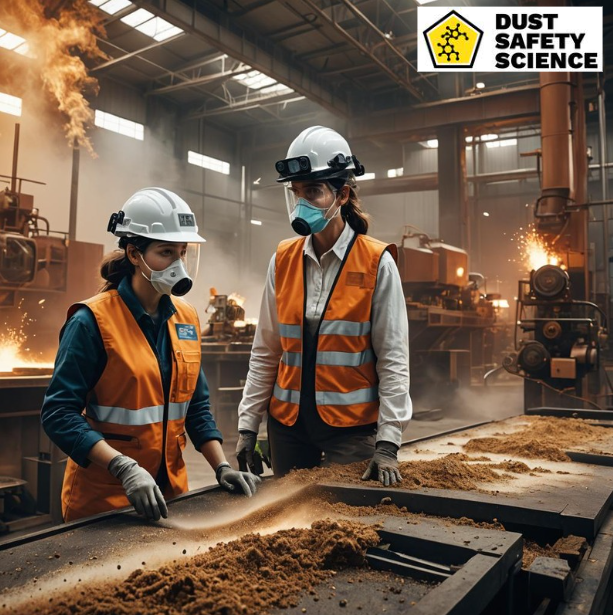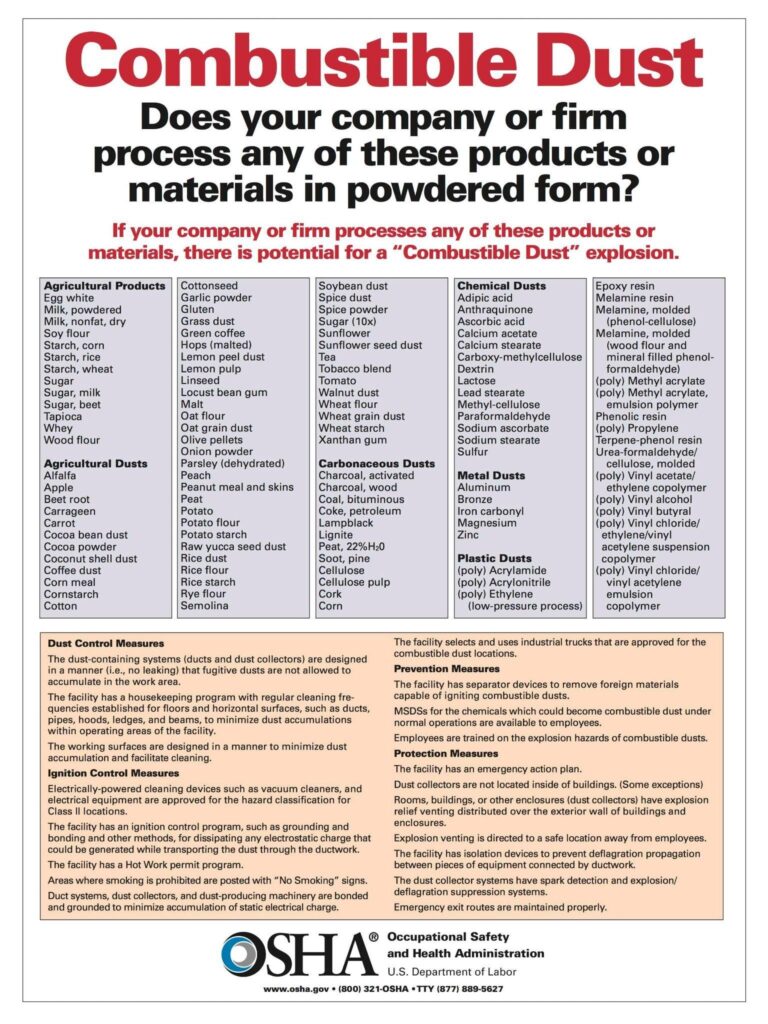Published September 23, 2024 Authored by Dr. Chris Cloney and Jon Barrett of Dust Safety Science

What is a Biomass Dust Explosion?
Biomass dust explosions occur when fine particles of biomass material become airborne, ignite, and lead to violent and often devastating blasts. These explosions pose significant risks to workers, facilities, and surrounding communities. Understanding the causes and implementing effective prevention strategies is crucial for anyone involved in biomass production and processing.
As the global push towards sustainable energy continues, biomass has emerged as a popular renewable energy source. It is derived from organic materials, including wood chips, agricultural waste, and other plant-based materials, that can be used for energy generation. While biomass offers significant environmental benefits, it also introduces serious safety risks, particularly with dust explosions.
Definition and Science Behind Biomass Dust Explosions
A biomass dust explosion occurs when fine particles of organic material become suspended in the air, are exposed to an ignition source, and ignite in a confined or semi-confined space. The science behind dust explosions involves the rapid combustion of these particles, which creates a sudden increase in pressure and heat, resulting in a destructive blast.
What Constitutes Biomass Dust?
Biomass dust refers to fine particles that are byproducts of biomass processing, such as wood, straw, agricultural waste, and other plant-based materials. When processed, biomass materials generate these fine particles, which can accumulate on surfaces, in equipment, and in the air.
Dust accumulation, particularly combustible dust, poses significant hazards that can lead to devastating explosions and fires. Understanding how to remove combustible dust from the air safely and effectively, is essential to protect workers, equipment, and the manufacturing facility.
Fine particles, such as combustible dust, can easily ignite and lead to dust explosions, which are often catastrophic. These combustible dust explosions occur when dust accumulates and becomes airborne, creating a dust cloud that can be ignited by heat sources, such as machinery, electrical sources, sparks, friction, or static electricity.
Conditions That Lead to Dust Explosions
For a biomass dust explosion to occur, five specific conditions, often referred to as the “Dust Explosion Pentagon,” must be met:
- Combustible dust – Biomass dust is inherently combustible due to its organic composition.
- Ignition source – Sparks from machinery, open flames, or hot surfaces can ignite the dust.
- Oxygen – Sufficient oxygen is required for combustion.
- Dispersion – The dust must be suspended in the air in the right concentration.
- Confinement – The explosion becomes more severe when it occurs in a confined or enclosed space, like a silo or processing room.
Factors Contributing to Biomass Dust Explosions
Several factors influence the likelihood of a dust explosion in biomass processing:
- Particle Size and Moisture Content: Fine particles pose a greater explosion risk because they can be more easily dispersed in the air. However, the moisture content of biomass also plays a critical role. Dry biomass dust is much more combustible, whereas higher moisture content reduces flammability.
- Dispersion and Concentration: When biomass dust becomes airborne in sufficient concentrations, the risk of explosion increases. Too little dust and the mixture won’t ignite; too much, and the dust can’t remain suspended long enough to explode.
- Ignition Sources: Common ignition sources in biomass facilities include overheated machinery, sparks from metal tools, static electricity, and malfunctioning equipment. The proximity of ignition sources to dust-prone areas is a significant risk factor.
Analysis and Case Studies of Past Biomass Dust Explosions
Biomass dust explosions are not a new phenomenon, and their occurrence highlights the importance of stringent safety measures.
Case Study 1: Georgia Biomass Explosion (2011)
In 2011, the Georgia Biomass wood pellet processing plant in, Waycross, Georgia, experienced a severe dust explosion. The explosion, which occurred near a pellet cooler, led to equipment damage, with no injuries reported. Investigations revealed that dust accumulation in the equipment, combined with inadequate ventilation and cleaning procedures, contributed to the explosion. The incident underscored the importance of regular dust cleaning and proper maintenance of equipment to avoid ignition sources.
Case Study 2: Tilbury Power Station (2012)
According to The Guardian, a severe blaze occurred at the Tilbury power station in Essex, England. There are no reports of any injuries and all employees at the plant, have been accounted for.
The fire, which started in a hopper containing the wooden pellets the biomass station uses to produce power, was described by one senior fire officer as among the most challenging he had dealt with in his 20-year career.
Statistics and Trends
Biomass dust explosions have been consistently reported in recent years, particularly in countries with robust biomass processing industries like the U.S., Canada, and Europe. Common factors in these incidents include poor dust management, insufficient risk assessments, and improper storage conditions.
Combustible dust incidents, continue to occur worldwide and in the Biomass industry, as presented in this combustible dust research and incident database from Dust Safety Science. In addition, statistics of the most prevalent industries, and industrial production, regarding combustible dust incidents, are also captured in this Annual Incident Report Database, from Dust Safety Science.
Identifying Potential Hazard Zones and Risk Assessment Strategies
To minimize the risk of biomass dust explosions, it’s essential to identify areas in the facility where dust accumulation and dispersion are most likely to occur. These hazard zones typically include:
- Processing equipment such as grinders, chippers, and dryers.
- Conveyors and transport systems that move biomass materials.
- Dust collection systems and filters.
- Storage silos and hoppers.
Tools and Technologies for Monitoring Dust Levels
Modern dust monitoring technologies can provide real-time data on dust concentrations within a facility. Optical particle counters and laser diffraction instruments are commonly used to measure particle size and concentration in the air. Additionally, infrared sensors can detect hotspots on machinery that could ignite accumulated dust.
Creating a Biomass Dust Hazard Analysis
A comprehensive dust hazard analysis, (DHA, is critical for identifying and mitigating explosion risks. The dust hazard analysis process should involve:
- Assessment of Dust Properties: Understanding the explosiveness of the specific biomass dust generated.
- Mapping Hazardous Areas: Identifying areas where dust is likely to accumulate and the potential ignition sources.
- Evaluating Existing Controls: Assessing current engineering and operational controls in place to prevent dust explosions.
- Recommendations for Improvement: Develop action plans to address gaps in safety measures.
The risk assessment team should include facility engineers, safety officers, and operations personnel who understand the plant’s unique processes and hazards.
Engineering Controls, Prevention, and Mitigation Techniques for Biomass Dust Explosions
- Ventilation Systems and Dust Extraction Solutions: Proper ventilation systems are vital to reduce airborne dust concentrations. Dust extraction systems, including cyclone separators and baghouses, can remove dust particles before they accumulate in hazardous concentrations. These systems should be regularly inspected and maintained to ensure optimal performance.
- Design Modifications: Equipment and facility design can also influence dust accumulation. Rounded edges, sealed machinery, and the elimination of flat surfaces where dust can settle are practical design considerations to reduce explosion risks.
- Operational Controls and Proper Handling and Storage: Minimizing the handling and transfer of biomass materials reduces the chances of dust becoming airborne. When necessary, transfer operations should be conducted in enclosed systems to contain dust. Additionally, storage areas should be regularly monitored for dust buildup.
- Routine Cleaning Procedures: Routine cleaning is a fundamental aspect of dust control. The use of non-sparking tools and specialized vacuum systems can help safely remove accumulated dust from hard-to-reach areas.
- Safety Practices and Employee Training: Employees must be trained on the specific risks associated with biomass dust, including how to prevent dust accumulation and what to do in the event of an explosion. Regular safety drills and the availability of personal protective equipment (PPE) can further mitigate risks.

Regulatory Compliance and Standards
Several safety standards and guidelines govern the handling and processing of combustible biomass dust:
- NFPA Standards: The National Fire Protection Association, (NFPA), provides detailed guidelines in NFPA 652 and NFPA 664, which focus on the prevention of fire and dust explosions in wood processing and biomass facilities.
- OSHA Guidelines: The Occupational Safety and Health Administration (OSHA) enforces standards for managing combustible dust under the General Duty Clause, which requires employers to maintain a safe working environment.
Implementing Compliance Measures
To ensure compliance, facilities should:
- Conduct regular audits to evaluate adherence to NFPA and OSHA standards.
- Maintain comprehensive documentation, including dust hazard analyses, cleaning logs, and safety training records.
- Report any incidents or near-misses to relevant authorities to improve safety practices and prevent future explosions.
Technology Advances, with the Integration of Artificial Intelligence, (AI), and Machine Learning, (ML), and Preventing Biomass Dust Explosions
Technological advancements in Artificial Intelligence (AI), the Internet of Things (IoT), and Machine Learning (ML) are transforming Biomass dust safety management in AI-driven systems, combined with IoT sensors, which can continuously monitor dust levels, temperature, humidity, and other environmental conditions in real time. This technology enables businesses to detect abnormal conditions before they escalate into hazardous situations. For example, IoT-connected dust sensors can provide continuous data on particulate levels, allowing AI algorithms to identify patterns, predict potential dust explosions, and trigger automatic alerts or shut down systems to prevent incidents.
Machine Learning enhances these capabilities by analyzing historical data from Biomass dust explosions and improving predictive models over time. ML algorithms can identify previously unnoticed correlations between different risk factors, providing more accurate risk assessments and allowing companies to implement more effective preventive measures. Additionally, these technologies help optimize maintenance schedules by predicting when equipment failures might occur, reducing the likelihood of malfunction-related dust accumulation. Together, AI, IoT, and ML are creating smarter, more proactive safety management systems, reducing human error, and enhancing overall workplace safety in hazardous environments.

Conclusion
Biomass dust explosions are a significant safety concern for any facility involved in biomass production and processing. However, with proper risk assessments, engineering controls, and employee training, these risks can be effectively mitigated. By adhering to regulatory standards and adopting best practices, biomass facilities can continue to benefit from this renewable energy source while ensuring the safety of workers and the community.
Ensure your facility is equipped to manage biomass dust safely. Conduct a hazard analysis, implement dust control systems, and stay compliant with NFPA and OSHA guidelines to prevent dangerous dust explosions.
About Dust Safety Science
Dr. Chris Cloney, of Dust Safety Science, provides additional information on Biomass Dust Explosions, with a Podcast. Click on the latest Podcast Links: Biomass Fibre Pile Management

Resources:
Visit: Fire and Explosion Protection Equipment Providers
Visit: Risk Assessment & Dust Hazard Analysis Providers
Visit:Combustible Dust Testing Providers
Visit Dust Safety Science (Global Incident Tracking)
Visit Dust Safety Academy (Resources, Training, and Events)
Visit Dust Safety Professionals (Need Help? Get Support Today!)
Visit Dust Safety Journal for the Dust Safety Science Monthly Journal
Subscribe to our FREE, Dust Safety Science Newsletter at Dust Safety Science Newsletter
Visit the Dust Safety Science blog for written articles on combustible dust safety including the latest research, expert opinions, and state-of-the art in fire and explosion protection.
